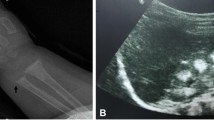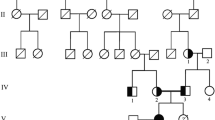Abstract
A 7-month-old male infant was referred for investigation after a documented febrile urinary tract infection. His past medical history was characterized by episodes of unexplained fever and mild dehydration. The ultrasound examination of his kidneys demonstrated bilateral diffuse medullary nephrocalcinosis. His serum and urine biochemistry revealed hypomagnesemia (0.4 mmol/l), hyperuricaemia (506 µmol/l), mildly increased iPTH (71 pg/ml) and hypercalciuria (16.0 mg/kg/day). The diagnosis of familial hypomagnesemia with hypercalciuria and nephrocalcinosis (FHHNC) was confirmed by mutational analysis of the CLDN16 gene, encoding paracellin-1. Sequencing displayed a homozygous Leu151Phe exchange affecting the first extracellular loop of paracellin-1. There were eight family relatives who underwent biochemical analysis, renal ultrasound and genetic investigation for CLDN16 mutations. Five of them were found to be heterozygous for the Leu151Phe mutation. Two heterozygotes (the mother and the maternal grandfather) presented with hypercalciuria. The grandfather had a history of recurrent passage of calculi. These findings point to the role of heterozygous CLDN16 gene mutations in renal pathophysiology. In conclusion, patients suspected of having FHHNC should be screened for CLDN16 mutations, especially with respect to genetic counseling. In addition, heterozygotes at risk should be clinically assessed in order to prevent renal complications of hypercalciuria.

Similar content being viewed by others
References
Rodriguez-Soriano J, Vallo A, Garcia-Fuentes M (1987) Hypomagnesaemia of hereditary renal origin. Pediatr Nephrol 1:465–472
Konrad M, Weber S (2003) Recent advances in molecular genetics of hereditary magnesium-losing disorders. J Am Soc Nephrol 14:249–260
Weber S, Schneider L, Peters M, Misselwitz J, Ronnenfarth G, Boswald M, Bonzel KE, Seeman T, Sulakova T, Kuwertz-Broking E, Gregoric A, Palcoux J-B, Tasic V, Manz F, Scharer K, Seyberth HW, Konrad M (2001) Novel paracellin-1 mutations in 25 families with familial hypomagnesemia with hypercalciuria and nephrocalcinosis. J Am Soc Nephrol 12:1872–1881
Cole DE, Quamme GA (2000) Inherited disorders of renal magnesium handling. J Am Soc Nephrol 11:1937–1947
Schwartz GJ, Brion LP, Spitzer A (1987) The use of plasma creatinine concentration for estimating glomerular filtration rate in infants, children, and adolescents. Pediatr Clin North Am 34:571–590
Pierrat A, Gravier E, Saunders C, Caira MV, Ait-Djafer Z, Legras B, Mallie JP (2003) Predicting GFR in children and adults: a comparison of the Cockcroft-Gault, Schwartz, and modification of diet in renal disease formulas. Kidney Int 64:1425–1436
Matos V, van Melle G, Boulat O, Markert M, Bachmann C, Guignard JP (1997) Urinary phosphate/creatinine, calcium/creatinine, and magnesium/creatinine ratios in a healthy pediatric population. J Pediatr 131:252–257
Weber S, Hoffmann K, Jeck N, Saar K, Boeswald M, Kuwertz-Broeking E, Meij IIC, Knoers NV, Cochat P, Sulakova T, Bonzel KE, Soergel M, Manz F, Schaerer K, Seyberth HW, Reis A, Konrad M (2000) Familial hypomagnesaemia with hypercalciuria and nephrocalcinosis maps to chromosome 3q27 and is associated with mutations in the PCLN-1 gene. Eur J Hum Genet 8:414–422
Michelis MF, Drash AL, Linarelli LG, De Rubertis FR, Davis BB (1972) Decreased bicarbonate threshold and renal magnesium wasting in a sibship with distal renal tubular acidosis: Evaluation of the pathophysiological role of parathyroid hormone. Metabolism 21:905–920
Rodriguez-Soriano J, Vallo A (1994) Pathophysiology of the renal acidification defect present in the syndrome of familial hypomagnesaemia-hypercalciuria. Pediatr Nephrol 8:431–435
Praga M, Vara J, Gonzalez-Parra E, Andres A, Alamo C, Araque A, Ortiz A, Rodicio JL (1995) Familial hypomagnesemia with hypercalciuria and nephrocalcinosis. Kidney Int 47:1419–1425
Benigno V, Canonica CS, Bettinelli A, von Vigier RO, Truttmann AC, Bianchetti MG (2000) Hypomagnesaemia-hypercalciuria-nephrocalcinosis: a report of nine cases and a review. Nephrol Dial Transplant 15:605–610
Wolf MT, Dotsch J, Konrad M, Boswald M, Rascher W (2002) Follow-up of five patients with FHHNC due to mutations in the Paracellin-1 gene. Pediatr Nephrol 17:602–608
Nicholson JC, Jones CL, Powell HR, Walker RG, McCredie DA (1995) Familial hypomagnesaemia-hypercalciuria leading to end-stage renal failure. Pediatr Nephrol 9:74–76
Mourani C, Khallouf E, Akkari V, Akatcherian C, Cochat P (1999) Early hypomagnesemia, hypercalciuria and nephrocalcinosis: two cases in a family. Arch Pediatr 6:748–51
Kuwertz-Broking E, Frund S, Bulla M, Kleta R, August C, Kisters K (2001) Familial hypomagnesemia-hypercalciuria in 2 siblings. Clin Nephrol 56:155–161
Blanchard A, Jeunemaitre X, Coudol P, Dechaux M, Froissart M, May A, Demontis R, Fournier A, Paillard M, Houillier P (2001) Paracellin-1 is critical for magnesium and calcium reabsorption in the human thick ascending limb of Henle. Kidney Int 59:2206–2215
Simon DB, Lu Y, Choate KA, Velazquez H, Al-Sabban E, Praga M, Casari G, Bettinelli A, Colussi G, Rodriguez-Soriano J, McCredie D, Milford D, Sanjad S, Lifton RP (1999) Paracellin-1, a renal tight junction protein required for paracellular Mg2+ resorption. Science 285:103–106
Muller D, Kausalya PJ, Claverie-Martin F, Meij IC, Eggert P, Garcia-Nieto V, Hunziker W (2003) A novel claudin 16 mutation associated with childhood hypercalciuria abolishes binding to ZO-1 and results in lysosomal mistargeting. Am J Hum Genet 73:1293–1301
Enriquez R, Sirvent AE, Amoros F, Martinez M, Cabezuelo JB, Reyes A (2003) Renal hypomagnesemia, hypercalciuria and nephrocalcinosis in a middle-aged man. Scand J Urol Nephrol 37:93–95
Gregoric A, Bracic K, Novljan G, Marcun-Varda N (2000) Pseudotumor cerebri in a child with familial hypomagnesemia-hypercalciuria. Pediatr Nephrol 14:269–270
Ulmann A, Hadj S, Lacour B, Bourdeau A, Bader C (1985) Renal magnesium and phosphate wastage in a patient with hypercalciuria and nephrocalcinosis: effect of oral phosphorus and magnesium supplements. Nephron 40:83–87
Kari JA, Farouq M, Alshaya HO (2003) Familial hypomagnesemia with hypercalciuria and nephrocalcinosis. Pediatr Nephrol 18:506–510
Tajima T, Nakae J, Fujieda K (2003) Two heterozygous mutations of CLDN16 in a Japanese patient with FHHNC. Pediatr Nephrol; 18:1280–1282
Author information
Authors and Affiliations
Corresponding author
Rights and permissions
About this article
Cite this article
Tasic, V., Dervisov, D., Koceva, S. et al. Hypomagnesemia with hypercalciuria and nephrocalcinosis: case report and a family study. Pediatr Nephrol 20, 1003–1006 (2005). https://doi.org/10.1007/s00467-005-1853-5
Received:
Revised:
Accepted:
Published:
Issue Date:
DOI: https://doi.org/10.1007/s00467-005-1853-5




